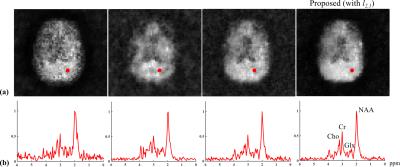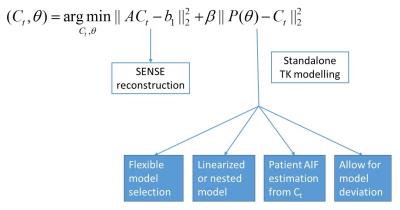Oral
Acquisition, Reconstruction & Analysis
Thursday, 27 April 2017
| Room 310 |
15:30 - 17:30 |
Moderators: Dong Liang, Claudia Prieto |
Slack Channel: #s_acq_recon_analysis
Session Number: O58
15:30
|
1197.
 |
Trajectory Correction of Radial Data Using MUSSELS 
Merry Mani, Sunrita Poddar, Vincent Magnotta, Mathews Jacob
Radial acquisitions are time efficient and flexible and enable several MR imaging applications. However, the sensitivity of radial acquisitions to trajectory deviations can result in severe artifacts in the images. We propose a trajectory correction method that can reconstruct the images for the ideal trajectory without the need for trajectory estimation or calibration.
|
15:42
|
1198.
 |
Echo-planar imaging with wave-CAIPI acquisition and reconstruction 
Benedikt A Poser, Berkin Bilgic, Borjan A. Gagoski, Kāmil Uludag, V Andrew Stenger, Lawrence L Wald, Kawin Setsompop
wave-CAIPI allows for high undersampling factors and hence acquisition speed-up in anatomical imagines sequences including 3D GRE, 2D SMS-TSE and MP-RAGE (3D TFL). The coil array’s full 3D sensitivity encoding is exploited, resulting in negligible g-factor penalties even in highly accelerated scans. Echo-planar imaging (EPI) sequences, both 2D and 3D EPI with Cartesian blipped-CAIPI have recently brought tremendous speed-up to BOLD and diffusion imaging in the neurosciences. We here explore the potential of going beyond blipped-CAIPI EPI by incorporating sinusoidal z- and y- gradient wave perturbations into the EPI readout. Initial results are shown for 3D wave-CAIPI EPI at 7T.
|
15:54
|
1199.
 |
Low-rank plus sparse tensor reconstruction for high-dimensional cardiac MRI 
Rebecca Ramb, Michael Zenge, Li Feng, Matthew Muckley, Christoph Forman, Leon Axel, Dan Sodickson, Ricardo Otazo
The recently proposed general low rank tensor framework enabled a paradigm change, where data acquisition and image reconstruction are represented in a higher-dimensional space. The overall data space is sampled only as different states randomly coincide, which leads to data gaps. These gaps can introduce challenges in spatiotemporal fidelity for only low-rank- or only sparsity-based reconstructions. Here, a $$$\mathcal{L}+\mathcal{S}$$$ tensor decomposition is investigated, which offers a more robust solution as the sparse component captures updates on top of the overall dynamics represented in the low-rank component. A free-breathing, T1-sensitive cardiac MRI with real-time Cartesian data acquisition over multiple cardiac and inversion recovery phases is employed to investigate potentials for comprehensive cardiac MRI, including for instance late gadolinium scar cine imaging.
|
16:06
|
1200.
 |
Extended Hybrid-SENSE: off-resonance and eddy corrected joint blip up/down reconstruction with reduced g-factor penalty 
Benjamin Zahneisen, Murat Aksoy, Julian Maclaren, Christian Wuerslin, Roland Bammer
Geometric distortions caused by off-resonant spins are a major issue in EPI based functional and diffusion imaging. We present a novel approach to the problem of geometric distortions. An extension of the model-based, algebraic hybrid-SENSE reconstruction method in combination with a known fieldmap, calculated from blip up/down scans, allows for correction of off-resonance effects during the reconstruction. This enables a joint blip up/down reconstruction that significantly reduces g-factor penalty if the blip-down trajectory is chosen to fill in missing k-space samples from the blip-up scan. The resulting high SNR images are automatically eddy-current corrected and geometric distortions are minimized.
|
16:18
|
1201.
 |
General Phase Regularized Reconstruction with Phase Cycling 
Frank Ong, Joseph Cheng, Michael Lustig
We present a general phase regularized image reconstruction method that is robust to phase wraps in initial solutions, with application to partial Fourier imaging, chemical shift imaging and flow imaging. The problem of constraining phase structures in reconstruction was studied under a regularized inverse problem framework. Since phase regularized reconstruction is inherently non-convex and sensitive to phase wraps in the initial solution, a reconstruction technique, named phase cycling, was proposed. The proposed method was applied to in vivo datasets and compared with state of the art reconstruction methods. The proposed phase cycling reconstruction provides an alternative way to perform phase regularized reconstruction, without the need of performing phase unwraping. It is robust to the choice of initial solutions and flexible to incorporate into different phase imaging applications.
|
16:30
|
1202.
 |
Accelerated J-Resolved MRSI Using Joint Subspace and Sparsity Constraints 
Fan Lam, Bowen Cheng, Zhi-Pei Liang
A new reconstruction method for accelerated J-resolved MRSI acquisitions is proposed. The proposed method performs a joint reconstruction from the data acquired with multiple echo times (TEs), using a formulation that integrates a subspace representation of the entire J-resolved spatiospectral function and a joint sparsity constraint exploiting the correlation across different TEs. Both simulation and in vivo experiments have been performed to evaluate the proposed method, demonstrating its superior performance over methods using joint sparsity or subspace constraint alone.
|
16:42
|
1203.
 |
Accurate, Rank-Adaptive Reconstruction of Undersampled Dynamic MRI Data Using Bayesian Information Criterion 
Julia Velikina, Alexey Samsonov
Dynamic MRI must contend with imaging time limits imposed by physiological and physical constraints. Methods promoting low-rank solutions have become increasingly popular for dynamic MRI acceleration due to their ability to reconstruct from limited data. In this work we present a novel model-based reconstruction approach exploiting statistical machinery to spatially adapt the model to underlying signal. It overcomes deficiencies of low-rank techniques to preserve complex temporal dynamics of physiological processes.
|
16:54
|
1204.
 |
Low Rank Approximation of High Resolution MRF through Dictionary Fitting 
Mingrui Yang, Yun Jiang, Mark Griswold, Debra McGivney
One of the challenges MRF faces is the amount of data needed to be stored, loaded, and processed, especially when a high resolution dictionary is needed or large multi-dimensional analyses need to be taken into account. A low rank approximation to the high resolution MRF dictionary using a coarse dictionary is an effective remedy to this problem. Here we present one of many possible ways to implement low rank approximation to an arbitrary fine MRF dictionary by a coarse dictionary equipped with polynomial fitting, so as to avoid the need of pre-calculating, storing, and processing the large, finely-resolved MRF dictionary.
|
17:06
|
1205.
 |
Accelerated z-Spectrum Imaging 
Melany Mclean, Matthew MacDonald, R. Marc Lebel, Mathieu Boudreau, Bruce Pike
Long acquisition times preclude many potential applications of z-spectrum based imaging techniques, and have hindered their widespread use. Using SparseSENSE, a combined parallel imaging and compressed sensing acceleration technique, we present a method to reduce the acquisition time of z-spectrum images by a factor of 16. Z-spectrum images have been retrospectively undersampled to simulate 2-20× acceleration factors. Sparsifying reconstruction algorithms enable high quality image reconstructions for ambitious acceleration factors and are shown to maintain z-spectrum accuracy.
|
17:18
|
1206.
 |
Reconstruction of DCE tracer kinetic parameters from under-sampled data with a flexible model consistency constraint 
Yi Guo, Sajan Goud Lingala, Krishna Nayak
Recently, it has been shown that DCE-MRI tracker-kinetic (TK) parameter maps can be directly estimated from under-sampled (k,t)-space data. Two major limitations of this approach are that 1) the gradient of a complicated cost function with respect to each TK parameter needs to be computed, and 2) it does not allow for any TK model deviation in the data. In this work, we present an alternative formulation where instead of forcing every voxel to follow the selected TK model, the model consistency is used as a constraint with a weighting penalty. This method is uniquely compatible with the use of multiple or nested TK models, and we show that it provides more accurate TK parameter restoration.
|
|










